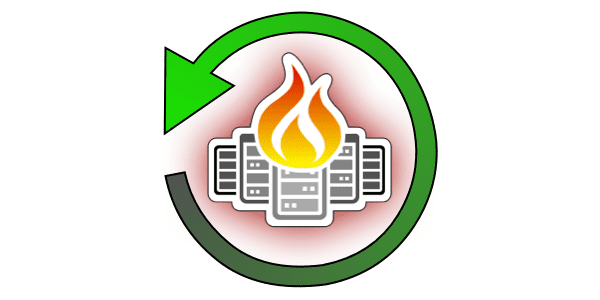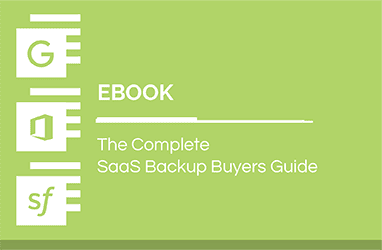What is a Disaster Recovery Plan? Importance, Types, Components & Benefits
Data disasters and business downtime due to cyberthreats, employee mistakes, technical glitches or natural disasters can be catastrophic for your business. Without a disaster recovery plan (DRP), such events can potentially put you out of business for good.
According to the U.S. Small Business Administration, over 50% of businesses fail to reopen following a disaster. Unfortunately, disasters often strike without warning. That’s why preparation is key to quickly recovering from any event that may result in data loss or interrupt business functions.
In this article, we will delve deeper into the importance of a disaster recovery plan, different types of DRPs and their benefits, and how to reinforce your organization’s disaster recovery plan.
What is a disaster recovery plan?
A disaster recovery plan is a documented strategy including policies, procedures and responsibilities to help organizations recover their IT systems and data in the aftermath of a disaster. It contains detailed guidelines on how an organization should respond to disruptive events, such as cyberattacks, power outages, application failure or human error. A DRP is a critical component of a business continuity plan. It enables organizations to recover from unplanned incidents effectively and resume business operations as quickly as possible.
What is the purpose of a disaster recovery plan?
The main goal of a disaster recovery plan is to minimize business disruption following a disaster, cyber incident or data loss event. Disaster recovery planning is critical to responding to unforeseen catastrophic incidents effectively and mitigating the effects on business. A well-established disaster recovery plan reduces recovery times, minimizes data loss and downtime, and ensures rapid recovery. It allows businesses to resume operations swiftly with minimal or no disruption after an unexpected event.
Why is it important to have a disaster recovery plan?
Whether natural or man-made, disasters can wreak havoc on businesses, resulting in data loss, damaged IT infrastructure and operational standstills. A disaster recovery plan outlines steps to minimize disruptions and expedite recovery after a disaster strikes. A robust DRP ensures business continuity by establishing clear steps to restore critical systems, applications and data. It helps organizations maintain essential functions during and after a crisis.
A well-structured disaster recovery plan also enhances resilience. It allows businesses to adapt to unexpected situations effectively, mitigating the impact and accelerating recovery. Additionally, compliance requirements often mandate the implementation of a disaster recovery plan in many industries. Adhering to these regulations not only avoids penalties but also demonstrates your commitment to operational reliability and customer service.

How does disaster recovery planning differ from business continuity planning?
While closely related, a disaster recovery plan and a business continuity plan (BCP) are two distinct strategies aimed at mitigating risks during unforeseen events and serve different purposes.
A disaster recovery plan focuses on the restoration of IT infrastructure and data following a disruptive incident. It outlines specific steps and procedures to recover critical systems, applications and data to minimize downtime and ensure operational continuity.
On the other hand, a business continuity plan encompasses a broader scope beyond IT. It contains plans for personnel, facilities, communications and business processes to maintain essential operations during and after a disaster. Business continuity planning includes DRP as a subset but also covers other aspects, such as employee safety, crisis communication and resource management.
Incident response plan vs. disaster recovery plan
An incident response plan (IRP) concentrates on immediate actions that must be taken when a security breach, cyberattack or any incident occurs. The main objective of an IRP is to reduce recovery times and costs associated with an IT incident. It outlines protocols for identifying, containing, mitigating and eradicating the incident rapidly. Incident response planning aims to minimize the damage caused by an incident, preserve evidence for analysis and facilitate the organization’s return to normal operations.
A disaster recovery plan primarily focuses on restoring and recovering critical IT systems, applications and data after a catastrophic event. It outlines specific steps to minimize downtime, restore operations and ensure data integrity.
What are some different types of disaster recovery plans?
There are different types of disaster recovery plans to ensure your business can recover effectively in the face of disasters. Each of these plans plays a crucial role in safeguarding different aspects of your organization’s IT infrastructure and caters to specific organizational needs. Selecting a specific plan or combining different plans depends on the nature of your business, the criticality of systems, budget considerations and regulatory requirements.
Network disaster recovery plan
A network disaster recovery plan (NDRP) focuses on restoring network infrastructure and connectivity after a disruptive event, such as a natural disaster, cyberattack or technical failure. It includes strategies and procedures for identifying vulnerabilities, backing up configurations, reconfiguring network infrastructure and establishing alternative communication channels to maintain connectivity.
Data center disaster recovery plan
A data center disaster recovery plan (DCDRP) is a crucial strategy that outlines procedures for recovering servers, storage systems and infrastructure components housed within a data center facility. It involves assessing vulnerabilities, defining recovery time objectives (RTOs) and recovery point objectives (RPOs), establishing failover mechanisms and maintaining off-site backups for data redundancy. Data centers play a vital role in storing, processing and managing your organization’s critical information; therefore, a comprehensive data center disaster recovery plan is paramount.
Cloud disaster recovery plan
Cloud disaster recovery plans leverage cloud services for data storage, backup and recovery. Organizations store critical data and replicate systems in the cloud to ensure redundancy and availability. The flexibility and scalability of cloud solutions enable rapid recovery and accessibility from anywhere with an internet connection. Additionally, cloud disaster recovery plans often include automated backup processes, reducing the need for manual intervention.
Virtualized disaster recovery plan
A virtual disaster recovery plan involves replicating workloads to a virtual environment for quick recovery and seamless business continuity in the face of an IT disaster. Disaster recovery with virtualized workloads is easier, quicker and more cost-effective than with a physical setup.
Disaster Recovery-as a Service (DRaaS)
DRaaS is a subscription-based model offering disaster recovery capabilities hosted and managed by a third-party provider. It provides a comprehensive solution, including hardware, software and expertise, to facilitate rapid recovery in case of a disaster. DRaaS often integrates with cloud services, providing flexible and cost-effective recovery options. It allows organizations to outsource the complexity of disaster recovery planning and implementation, ensuring expert management of critical systems and data.
What should be included in a disaster recovery plan?
A comprehensive disaster recovery plan serves as a critical roadmap for organizations to navigate through crises and minimize disruptions. An effective DRP should include several key components to respond to various disaster scenarios swiftly and efficiently:
- IT inventory: Creating an inventory of IT assets will provide a clear understanding of critical systems, applications, hardware and data that are essential for business operations.
- Roles and responsibilities: Define roles and responsibilities for each team member involved in the recovery process. Establishing a clear chain of command and outlining specific duties during a crisis helps streamline actions and decision-making.
- Goals and objectives: Establishing clear goals and objectives aligns the recovery process with the broader business strategy and ensures a focused approach. Define what your RTO/RPO goals are and set benchmarks for recovery performance, outlining acceptable downtime and service restoration expectations.
- Backup procedures: Regular backups are fundamental to data protection and serve as a foundational element of disaster recovery. Define the frequency and methodology for data backups (incremental, differential or full) based on criticality. Specify where backups are stored, ensuring redundancy and accessibility during recovery. Implement regular checks to verify the integrity and restorability of your backups.
- Disaster recovery procedures: Outline detailed procedures for recovering critical systems and operations, including incident response protocols and recovery workflow. Create step-by-step processes to restore systems, applications and data, considering various disaster scenarios. Establish communication channels and protocols to keep stakeholders informed during the recovery process.
- Testing strategy: Regular testing ensures the readiness and effectiveness of your disaster recovery plan. Define how often the plan will be tested (quarterly, semi-annually or annually). Create scenarios simulating different disaster scenarios to assess the plan’s effectiveness. Document results, identify weaknesses and update the plan based on test outcomes.
- Plan documentation: Thorough documentation ensures accessibility and clarity when executing your DR plan during stressful situations. Maintain updated versions of your disaster recovery plan, clearly labeling revisions and changes. Ensure easy access to the plan for relevant stakeholders, both in digital and hardcopy formats.
What are the benefits of a disaster recovery plan?
A disaster recovery plan is a proactive strategy that offers numerous benefits to organizations of all sizes:
- Minimized downtime: Disaster recovery planning helps minimize downtime by enabling swift recovery and reducing operational disruptions.
- Data protection: Backups are an important element of a disaster recovery plan. Creating a copy(ies) of your data and storing it in a secure location helps safeguard critical information against loss or corruption.
- Enhanced resilience: A DRP enhances resilience by enabling you to adapt swiftly to unexpected situations. Regularly testing and updating your DRP will help identify weaknesses and strengthen the plan, thereby improving overall resilience against potential threats.
- Business continuity: A comprehensive DRP ensures business continuity by outlining steps and best practices to maintain essential functions during and after a disaster. It also helps minimize the impact of disasters on business operations.
- Regulatory compliance: A robust disaster recovery plan ensures your organization’s operations and processes align with industry standards and legal requirements, assisting in regulatory compliance.
- Reduced financial loss: Disaster recovery planning helps mitigate revenue loss and potential legal liabilities. According to IBM’s Cost of a Data Breach Report 2023, organizations with high levels of incident response planning and testing saved $1.49 million compared to those with low levels.
- Enhanced stakeholder confidence: Having a well-structured disaster recovery plan demonstrates your organization’s preparedness and commitment to operational reliability. This helps maintain confidence among stakeholders, including customers, investors and employees, reassuring them that your organization is prepared to navigate through crises effectively.
Support your disaster recovery plan with Spanning Backup
The harsh reality about disasters is no business is safe — they can and will strike. The most important question is, “Are you prepared?”
In the event of a disaster, quick recovery is crucial to bounce back as quickly as possible and minimize the negative impacts on your business.
Strengthen your organization’s resilience with Spanning Backup for Google Workspace, Microsoft 365 and Salesforce. Spanning’s automated daily backups ensure the continuity and availability of your data by storing a copy securely in the cloud outside of the primary infrastructure. Our rapid restore feature allows you to recover information swiftly, minimizing downtime and ensuring business continuity in the face of an unexpected event. The end-user self-service restore capability empowers your employees to find and restore lost data without IT intervention.
“With Spanning Backup, we can sleep easy knowing that in the worst-case scenario, we can quickly recover business-critical data even if we somehow lost it from our main accounts. It’ll pay its biggest dividends at the most stressful moments in the future.” Will Critchlow, founder and CEO, Distilled
Schedule a personalized demo today to witness how Spanning can help recover your valuable SaaS data in minutes.





